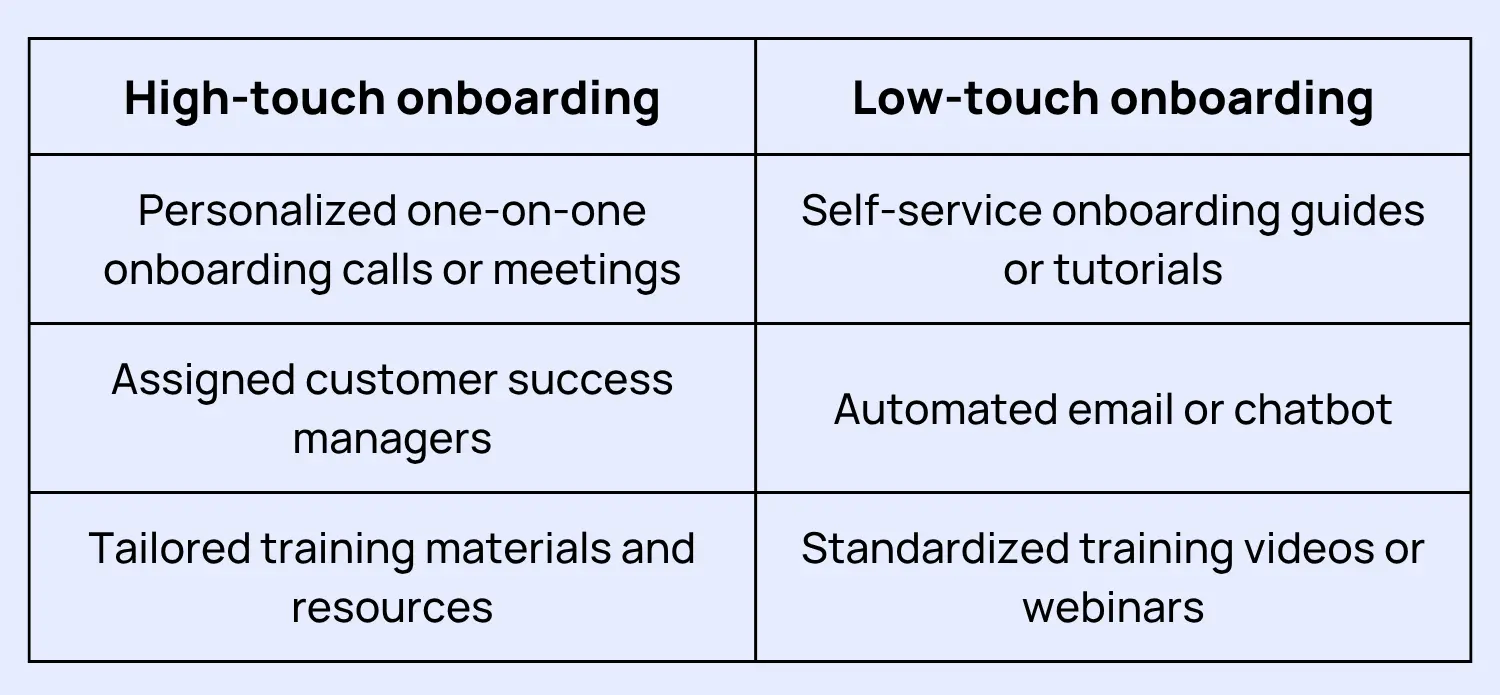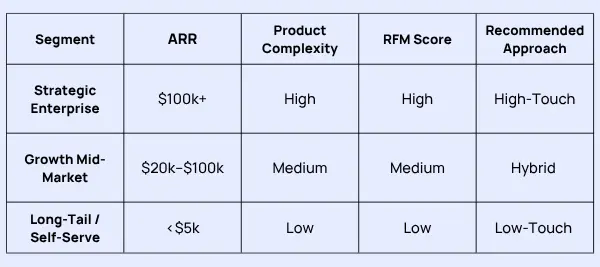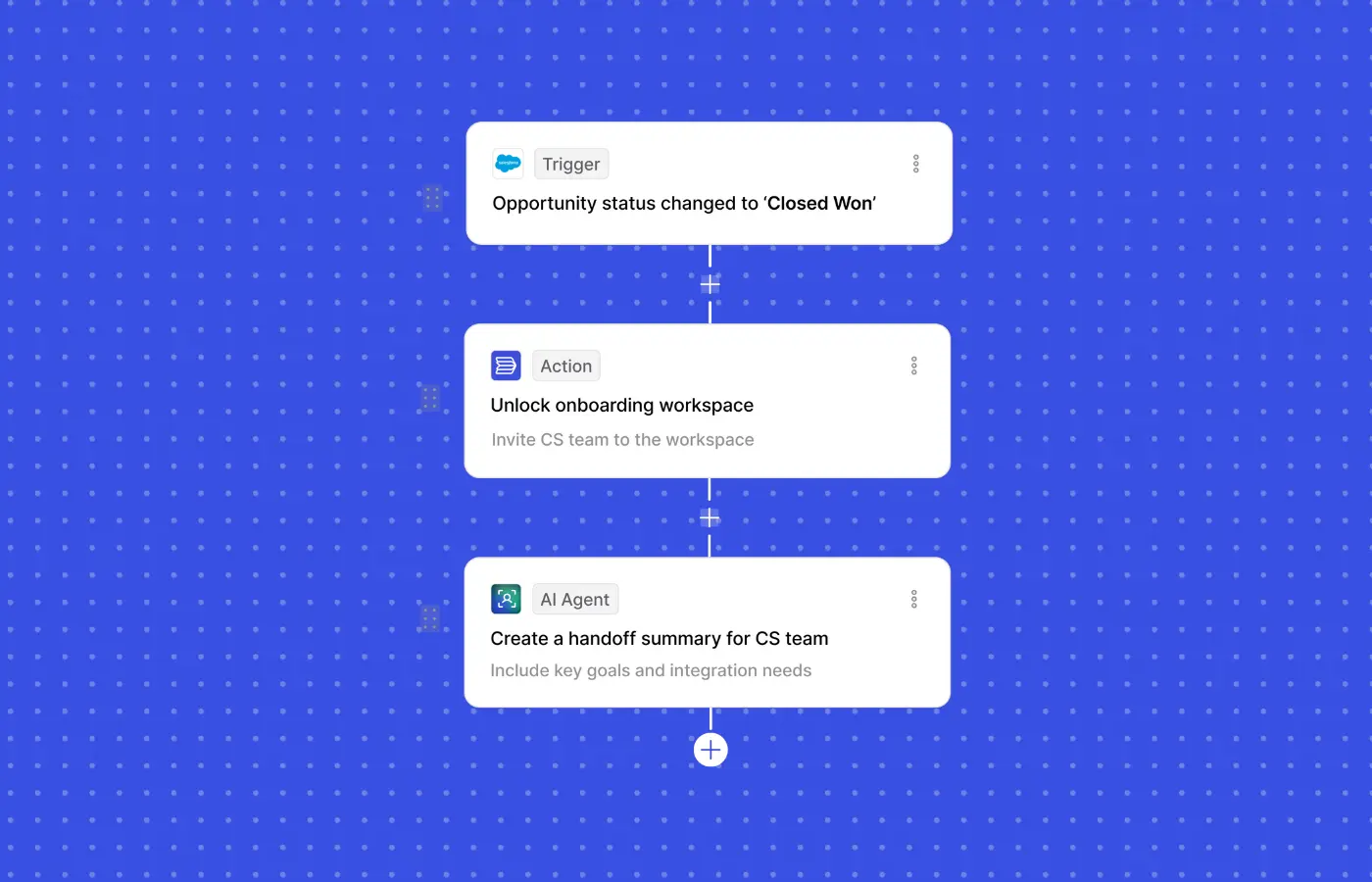How to Build a High-Touch Onboarding Process That Scales: Hands-on Guide
.webp)
Your customer just signed the contract. The hard part's over, right?
Not quite. In today’s landscape, onboarding is where the real customer experience begins. It’s also where deals are either reinforced… or quietly unravel. No matter how intuitive your product may be, most users still need a bit of guidance to unlock its full value (and fast).
Meanwhile, buyer expectations have never been higher. People want outcomes, not just access. Add to that the pressure to make every dollar of CAC count, and suddenly, your onboarding process isn’t just a handover from sales to CS – it’s a critical growth lever.
And the numbers back it up: over 90% of buyers say companies could improve their onboarding experience, and 55% have returned a product because they didn’t know how to use it.
That’s where high-touch onboarding comes in, blending personal guidance, proactive support, and strategic planning to help customers succeed from day one.
Let’s break it down and look at how to do high-touch onboarding the right way.
What is high-touch onboarding?
High-touch onboarding is a customer-centric approach that prioritizes personal interactions and tailored guidance over generic, one-size-fits-all experiences. It typically involves more frequent, hands-on touchpoints between your customer success team and the customer, often supported by customer collaboration tools like shared onboarding workspaces, video calls, and mutual action plans.
The goal? To make it easier for customers to adopt your product, align it with their goals, and start seeing value from day one. This strategy creates a memorable first impression that strengthens satisfaction, loyalty, and long-term retention.
Unlike low-touch or tech-touch models that rely heavily on automation or self-service content, high-touch onboarding builds real relationships. It’s the difference between a welcome email and a welcome call. A link to a help article versus a live walkthrough. It’s not always the fastest or cheapest route, but for many customers, it’s the most impactful.
That said, not every customer needs the same level of attention. Choosing the right onboarding model shouldn’t start with tools; it should start with segmentation. We’ll dive into that shortly.
Key elements of high-touch onboarding
Every customer is unique and requires different levels of support and guidance. A high-touch onboarding approach is aware of that and is all about creating a personalized and hands-on experience for them. There are some simple elements to create such an environment for your customers:
- Clear communication: Giving clear and exhaustive information about your product and best practices for its usage, as well as being present to answer any questions from your customers, is the key to high-touch onboarding. You can also set up automated nudges tied to specific milestones (like account setup or first login) to reinforce that support without losing the human touch.
- Individual training: Your onboarding shouldn’t be too general – a high-touch approach implies personalized training programs tailored to the needs and goals of your customers. This could include curated success plans or training sessions focused on unlocking early value.
- Regular check-ins: Proactively reach out to your customers and see if they feel happy or satisfied with your product, and act upon any concerns or difficulties they might have. These check-ins can be triggered by specific events, such as periods of inactivity or the completion of a key task.
- Social interactions: Create authentic connections with your customers outside of your product – interact with them on social media, invite them to community spaces, or celebrate milestones. These white-glove moments help build personal, lasting relationships.
Together, these elements help deliver an onboarding experience that feels personal, intentional, and designed for long-term success.
Benefits of a high-touch onboarding experience
Implementing a high-touch onboarding model benefits both your customers and your business. It can increase customer retention by up to 10%, boost referrals by 16%, and significantly improve conversion rates by helping new users understand and adopt your product faster.
Other benefits of high-touch onboarding cover the following aspects:
- Customer success: Personalized onboarding drives immediate ROI and satisfaction by setting customers up for success from day one. Using structured tools like Mutual Action Plans (MAPs) also gives both parties a shared roadmap, making expectations and progress transparent.
- Personalized experience: Customers appreciate when companies take the time to understand their unique needs and goals. A high-touch approach ensures that onboarding is relevant, meaningful, and aligned with what matters most to each customer segment.
- Proactive problem-solving: High-touch onboarding enables you to identify and address issues early, often before the customer even notices them. Trigger-based workflows (e.g., inactivity alerts or milestone check-ins) allow your team to respond in real-time and prevent friction.
- Enhanced product understanding: Hands-on guidance and tailored training help customers grasp your product’s value more quickly. This builds user confidence and reduces the need for reactive support down the line.
- Relationship building: A personalized onboarding experience helps establish trust and stronger relationships, which in turn drive long-term loyalty, expansion opportunities, and a higher Net Revenue Retention (NRR).
Challenges in high-touch onboarding
Although high-touch onboarding has a positive impact on both customers and companies, it comes with its own set of challenges:
- Resource allocation: Providing personalized attention to every client can be difficult, especially as your customer base grows. Hiring, training, and managing enough team members to maintain a high-touch experience becomes increasingly complex at scale.
- Consistency across teams: Maintaining high standards and timely service across different teams, departments, or regions is challenging. Without proper training, documentation, and process alignment, the customer experience can become inconsistent.
- Technology integration: Striking the right balance between automation and human interaction is not easy. Integrating the right tools to support efficiency while preserving the personal touch requires thoughtful planning and execution.
- Time constraints: Personalized onboarding often involves multiple team members — including customer success managers, trainers, and support staff — who need to juggle onboarding alongside other responsibilities. As sales volume increases, keeping up becomes more difficult.
- Scaling culture: As your company grows, preserving its unique culture and values becomes more difficult. Ensuring that new customers not only understand your product but also connect with your brand’s identity requires intentional reinforcement during onboarding.
- Cost considerations: High-touch onboarding often involves significant investment, from hiring staff to building custom materials or implementing advanced tools. Balancing these costs against potential ROI requires a careful, data-driven approach.
What is a low-touch onboarding?
Low-touch customer onboarding is a strategy that relies on self-service onboarding tools and automation to help customers get started with a product on their own. In this model, the role of the customer success team is limited (or in some cases, entirely absent).
It often relies on resources like product tours, onboarding checklists, automated emails, and knowledge base articles. This approach is ideal for simple products, lower-tier plans, or high-volume segments where personalized onboarding may not be practical or cost-effective.
What is the difference between low-touch and high-touch onboarding?
Think of it like dining out. Low-touch onboarding is the self-service model, similar to a fast food restaurant where everything is automated, standardized, and efficient. High-touch onboarding, on the other hand, is like being served at a fine-dining establishment: It’s personalized, attentive, and focused on delivering a tailored experience.
The key differences lie in the level of interaction, scalability, and cost. High-touch onboarding requires more time and resources, but it provides greater value for strategic accounts, complex setups, or high-value customers. Low-touch onboarding is more scalable and efficient, but may lack the depth or personalization needed to drive early engagement in more nuanced use cases.
That’s why many companies are now adopting a hybrid approach, blending automated communications with targeted personal touchpoints. We’ll explore how to design onboarding models based on customer segments in the next section.

What is zero-touch onboarding?
As we explore the differences between high- and low-touch approaches, there’s one more option worth mentioning – zero-touch onboarding.
As the name suggests, the zero-touch approach aims to eliminate human interaction as much as possible during the onboarding process. It removes the need for manual assistance or intervention from customer support teams, allowing new users to get started with a product or service entirely on their own.
This model typically relies on well-designed user interfaces, smart defaults, embedded guidance, and fully automated workflows. It works best for simple, intuitive products or freemium/self-serve models, where scale and speed are key.
Low-tech high-touch vs high-tech low-touch onboarding approaches
Customer onboarding can also be viewed through the lens of technology vs. human interaction, giving rise to two contrasting approaches:
- Low-Tech, High-Touch Onboarding
This method focuses on personal support and in-depth consultation, often delivered manually or in person. It’s ideal for businesses that prioritize relationships and tailored support over automation. While powerful, it can be resource-intensive and difficult to scale as your customer base grows.
- High-Tech, Low-Touch Onboarding
This approach leverages technology like automation, AI, and in-app guidance to create efficient, scalable onboarding experiences. It enables customers to help themselves and move at their own pace. However, it may lack the personalization and relationship-building found in more hands-on methods.
Choosing the right model – or combining elements of a few – depends on your product complexity, customer segments, and internal resources. We'll explore how segmentation can guide this decision in the next section.
When to choose low-touch vs. high-touch onboarding?

How to implement the high-touch onboarding process?
Implementing a high-touch onboarding process requires careful planning and coordination. Below are the key steps to ensure it’s effective, scalable, and aligned with customer needs.
Start by segmenting your customers
Before designing any onboarding workflow, begin with customer segmentation. High-touch doesn’t mean “every customer gets the same treatment,” it means giving each customer the right level of support.
Segmenting helps you match onboarding effort to customer potential. Consider using a mix of:
- ARR (Annual Recurring Revenue): Prioritize white-glove onboarding for high-value accounts.
- Product complexity: The more technical or customizable the product, the more support users may require.
- Strategic value: Some accounts — like high-growth logos or enterprise partnerships — warrant extra attention due to their future potential.
- RFM scoring: Evaluate engagement by looking at Recency, Frequency, and Monetary value to flag customers who may need additional support.
Here’s a simple example of how segmentation could inform your onboarding model:

Once your segments are defined, you can tailor onboarding flows accordingly, making the best use of your team’s time while still delivering high-value experiences.
Other aspects of a successful high-touch onboarding process
- Train your team thoroughly so they not only understand the product but also know how to deliver a great customer experience. They should be comfortable leading onboarding conversations, answering questions, and proactively guiding customers.
- Assign ownership early. Designate a dedicated Customer Success Manager for each high-touch account to oversee progress and act as the single point of contact throughout the onboarding journey.
- Foster a collaborative environment within your team. Encourage open communication, internal knowledge sharing, and feedback loops to ensure consistency in onboarding delivery.
- Create a structured onboarding journey with clear phases, milestones, and timelines. Use Mutual Action Plans to align expectations, define responsibilities, and give both sides visibility into progress.
- Regularly collect feedback and measure success using KPIs like onboarding duration, product adoption, expansion rate, and Net Revenue Retention. These insights will help you identify what’s working and where to improve.
Common pitfalls and how to avoid them
Even the best-designed high-touch onboarding processes can run into issues. Here are a few common challenges to watch out for and how to address them:
- Over-segmentation: Creating too many small customer segments can lead to confusion, inconsistent experiences, and added operational complexity. Start with broad, clear categories and refine as needed over time.
- Template fatigue: If every onboarding experience feels identical, customers may disengage. Regularly review and refresh your templates, even small changes like adding a welcome video or adjusting timelines can make them feel more personal.
- Data gaps: Automations and triggers only work when the underlying customer data is complete and accurate. Missing fields like job title, stage, or usage behavior can break workflows or lead to irrelevant messaging.
- Flat metrics: Measuring onboarding success without segment-specific context can be misleading. Enterprise clients may take longer to onboard, but deliver higher long-term value. Make sure you track KPIs like onboarding duration, product adoption, and NRR by segment to get a clearer picture.
To avoid these pitfalls, review your onboarding flows regularly, collect feedback from both your team and your customers, and iterate based on what’s working. A good onboarding process is never static – it evolves as your customers and product do.
Build a scalable onboarding process with workflow automation in Flowla
Flowla 2.0 transforms onboarding from a manual, messy process into a streamlined, high-impact experience, blending automation with the personal touch your customers expect. Instead of chasing updates or manually coordinating stakeholders, you can build flows that do the heavy lifting for you, while still delivering white-glove moments that feel personal and intentional.
- Automate onboarding sequences with pre-built templates and conditional logic, so each customer gets a tailored experience without added effort from your team.
- Trigger reminders, task assignments, and updates automatically based on stage progression or stakeholder engagement.
- Centralize all onboarding materials in a single, interactive workspace, making it easy for customers and internal teams to stay aligned.
- Create clear, step-by-step action plans with embedded deadlines and ownership, driven by automation, not email back-and-forth.
- Monitor progress with real-time analytics to spot bottlenecks, track stakeholder activity, and identify when to intervene.
- Reduce time-to-value by automating handoffs, approvals, and notifications across CS, product, and sales teams.
With Flowla 2.0, high-touch onboarding is no longer high-maintenance. It’s scalable, efficient, and deeply personalized, helping you build trust and deliver value from day one.

Top 3 onboarding workflows to automate with Flowla
Even high-touch onboarding doesn’t have to mean high effort, especially when you combine Flowla with your existing tools. Here are a few workflow ideas you can build today to automate the busywork and focus your team on what matters most:
1. Kickoff trigger with CRM integration
When a deal is marked “Closed Won” in your CRM (like HubSpot or Salesforce), automatically generate a Flowla onboarding flow using the correct template based on the customer segment.
2. Inactivity-based check-in
Use product usage data or Slack alerts to trigger a check-in message if a customer hasn’t completed key onboarding steps within a set timeframe.
3. Milestone completion notification
When a customer completes a key onboarding task in Flowla (e.g., setup checklist or MAP milestone), send an automatic internal Slack alert or log the event in your CRM.
For more automation ideas, check out our Workflow Templates library.
Ready to level up your onboarding?
Flowla gives you everything you need to deliver personal, high-impact onboarding at scale, without adding more manual work. Start by segmenting your customers, then build flows that meet them where they are.
👉 Want a head start? Book a demo or explore more Workflows to see how you can launch your first onboarding flow in minutes.
Scale your onboarding process without comprimising on quality
Turn clunky spreadsheets and a million documents into one automated workflow your customers can follow.
See Flowla in actionRecommended for you
Want to discover Flowla?
Your first 5 rooms are free. No credit cards, no commitments.
.webp)


.webp)
.webp)
.webp)
.webp)